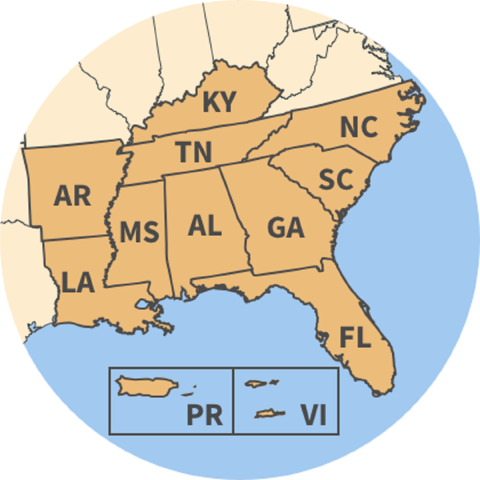The Southeast Region carries out this mission within the states of Alabama, Arkansas, Florida, Georgia, Kentucky, Louisiana, Mississippi, North Carolina, South Carolina and Tennessee, as well as Puerto Rico and the U.S. Virgin Islands. Our regional office is located in Atlanta, Georgia.
In This Region
- Alabama
- Arkansas
- Florida
- Georgia
- Kentucky
- Louisiana
- Mississippi
- North Carolina
- Puerto Rico
- South Carolina
- Tennessee
- Virgin Islands
As we move forward through a new century of conservation, the mission of the Southeast Region is to focus on the following as regional priorities. These three identified priorities flow directly from the mission of the United States Fish and Wildlife Service and are intended to help us focus our efforts to meet the challenges of the 21st century:
- Connecting with partners at all levels across the landscape to affect fish and wildlife conservation;
- Connecting with the resource to conserve, protect and enhance (manage); and
- Connecting with people to inspire value, support, enjoy and benefit from the fish and wildlife resources and their habitats.
We live and work in an amazing part of the country. The Southeastern United States is among the most biologically diverse hotspots in the world. Our Region includes Caribbean and coastal islands, marshes, coral reefs, the Appalachian and Ozark Mountains, caves, and longleaf and shortleaf pine and bottomland hardwood forests. Our work ensures that fish and wildlife populations continue in those places for the benefit of the American people.
In the Southeast, the Service is in the midst of a period where the magnitude of conservation challenges facing America’s fish and wildlife resources can be daunting.
Accelerating housing development, sea-level rise, more intense storms, increased land use changes, habitat loss and fragmentation, increased occurrence and abundance of invasive species invasive species
An invasive species is any plant or animal that has spread or been introduced into a new area where they are, or could, cause harm to the environment, economy, or human, animal, or plant health. Their unwelcome presence can destroy ecosystems and cost millions of dollars.
Learn more about invasive species , poorer water quality, a public largely disconnected from nature,and many other issues create noteworthy challenges for those of us charged with conserving and protecting these resources.
About 92% of the land in the Southeast is in private ownership creating both opportunities and challenges. History shows that our Nation faced challenges before, e.g., the Dust Bowl era of the 1930s, and we have always risen up to meet those challenges.
With a conservation goal of ensuring self-sustaining populations of native fish and wildlife across landscapes, the Service has a clear responsibility to provide leadership in addressing these challenges.
Continual progress over the long term is crucial if we are to remain relevant to future generations as the world’s premier conservation agency. Our challenge as conservation leaders is to produce the best results with available resources, using principles of conservation science to guide our resource management actions and to ensure that landscapes can support healthy, sustainable fish and wildlife populations. How we do this, and the consequences of our actions, are hugely important to all Americans, including the next generation of conservation leaders who will come after us. Their future success is dependent upon us.



